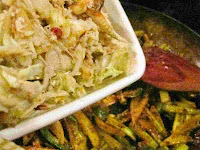<Ingredients>
1 Dungeness crab (approx. 550 g in shell, cleaned)
1/2 medium or 1/3 large onion
6 kinsai Chinese celery stalks
4-5 medium garlic cloves
3 eggs
1 jalapeno pepper
1 tbsp oil (not in photo)
1 tbsp nam prik pao chili paste in oil
1 1/2 tbsp curry powder
150 cc chicken stock
5 tbsp (75cc) coconut milk
2 tsp oyster sauce
2 tsp si-ew kao thin soy sauce or nam pla fish sauce
2 tsp brown sugar
***See notes for ingredients of the reduced-sodium version.***
<Directions>
1.
Remove part of crab shells so that crab is easy to eat in the final dish.
Crab shells are the key flavoring of this dish, so be sure to keep at least half of shells intact (don’t remove too much).
Save empty shells for another use.
2.
Mix oyster sauce, thin soy sauce and sugar, and set aside.
3.
Cut Chinese celery in 3-4 cm.
Remove seeds and thinly slice jalapeno pepper.
Thickly slice onion.
Finely chop garlic.
Lightly beat eggs.
4.
In a frying pan, heat oil and nam prick pao.
Add garlic, and saute on low heat until fragrant.
5.
Raise heat to medium, add onion, and saute until starting to turn translucent.
Add jalapeno pepper and Chinese celery stems, and stir.
6.
When jalapeno pepper and Chinese celery stems are coated with oil, add curry powder, and blend with vegetables.
Add crab and mix well, making sure crab surfaces come in contact with curry.
7.
Add chicken stock, and bring to boil.
Add oyster sauce mixture, stir, and cook for 1-2 minutes.
Add coconut milk, stir, and bring to boil.
8.
Swirl in egg, and roughly mix.
Add Chinese celery leaves, and roughly mix.
Ready to serve.
<Notes>
- If Chinese celery is not available, celery works (2-3 stalks) fine. Due to the thickness of celery stalks, slice them diagonally.
- Jalapeno or any spicy chili pepper is optional.
- This dish is originally cooked with fresh (not boiled) crab. If using fresh crab, crack open shells to the degree desired, and saute crab after sauteing garlic (in Process 4 above). After crab shells turn vivid red, continue with the remaining steps.
- If nam prik pao is not available, try a combination of shami dried Chinese shrimp (finely chopped) and red chili paste (Chinese, Thai or Vietnamese). This gives a somewhat similar taste, although not as complex as that of nam prik pao.
- For the curry powder above, I mixed 1 tbsp Indian curry powder and 1/2 tbsp turmeric powder, as Thai curry powder is very mild (much milder than Japanese, much much milder than Indian, and slightly milder than Chinese).
- Brown sugar is a substitute for palm sugar.
- This can be turned into very coconutty dish if you use thicker coconut cream. Tom: Sorry, but I prefer a subtle coconut taste.
- Ingredients (seasonings) for the reduced-sodium version: Cut back on oyster sauce, brown sugar, and nam pla (the nam pla brand I use contains 690mg sodium per tablespoon compared to 1,200-1,800 mg/tablespoon of many fish sauce brands; do not use si-ew kao thin soy sauce, as its sodium content is higher than most nam pla). Also, add some kurozu brown rice vinegar, as below.
1 1/2 tsp oyster sauce
1 tsp nam pla fish sauce
1/2 tsp kurozu brown rice vinegar
1 1/2 tsp brown sugar


















No comments:
Post a Comment